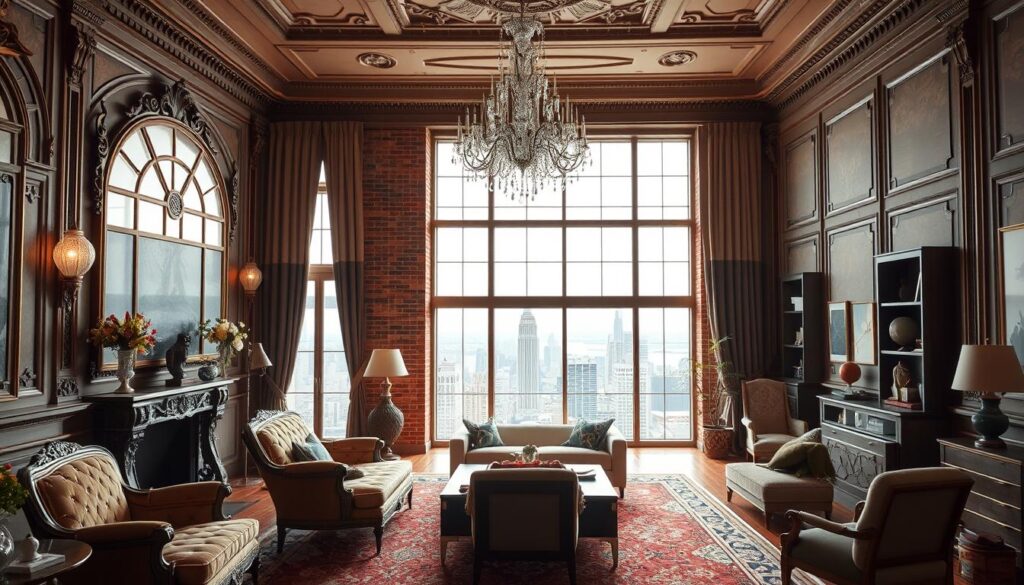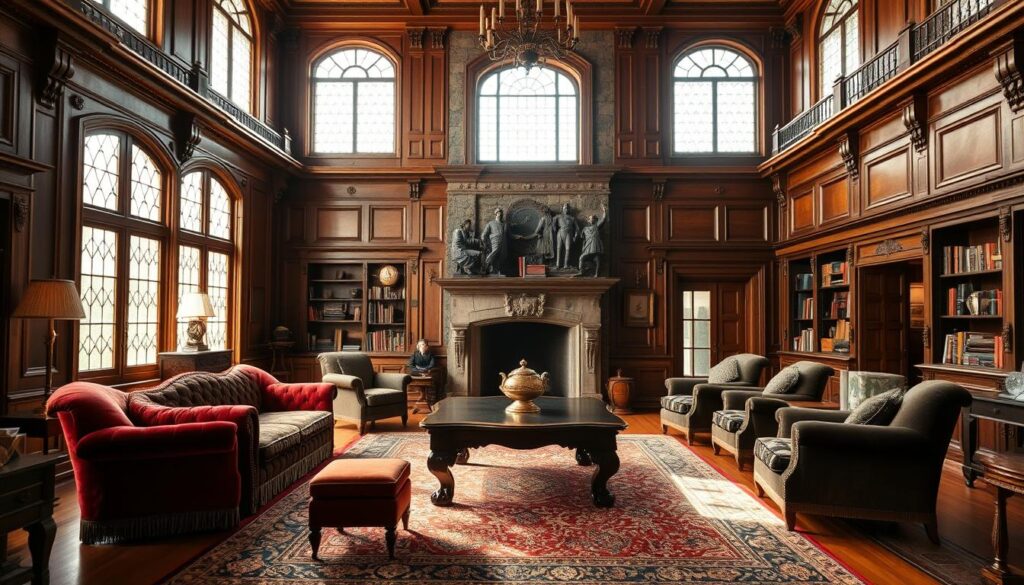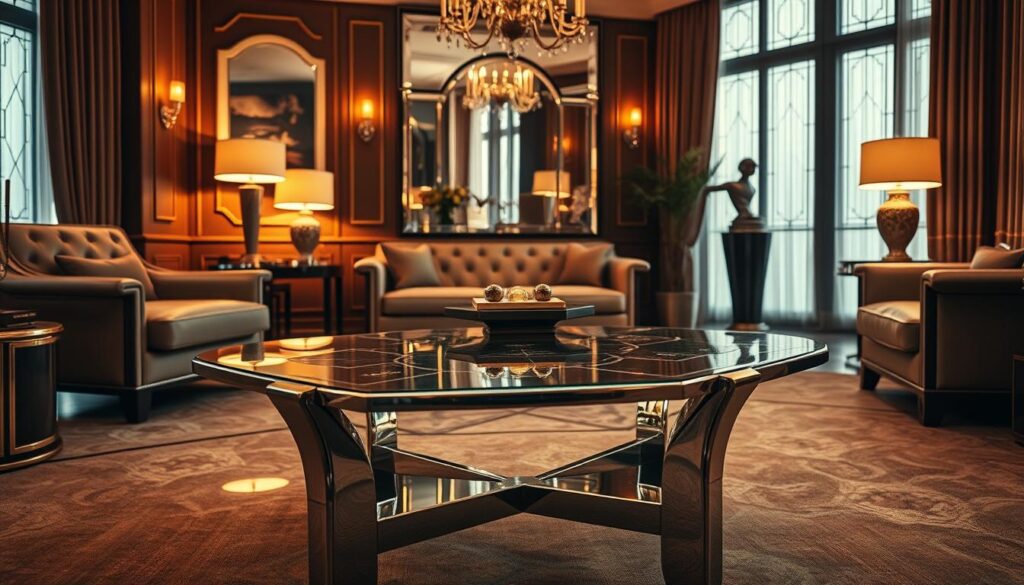Imagine stepping into a time capsule that takes you through the evolution of home decor and style over the decades. From the opulence of the early 20th century to the sleek minimalism of today, the history of how we Interior Design History our living spaces is a fascinating narrative of cultural, social, and technological changes.

This comprehensive guide will take you on a journey through the iconic styles, influential designers, and timeless trends that have shaped the industry. We’ll explore how historical events, cultural movements, and technological advancements have influenced the way we design our homes, creating a rich tapestry of design history.
Key Takeaways
- Understanding the evolution of home decor through the decades.
- Identifying key styles and trends that defined each era.
- Recognizing the impact of cultural and technological changes on design.
- Appreciating the work of influential designers who shaped the industry.
- Discovering timeless trends that continue to inspire modern design.
The Origins and Evolution of Design Aesthetics
The dawn of the 20th century marked a pivotal moment in the evolution of interior design. This era saw the emergence of new styles and the transformation of existing ones, laying the groundwork for modern interior design.
The Birth of Modern Interior Design
Modern interior design began to take shape with the influence of various cultural and artistic movements. The Arts and Crafts movement emphasized handmade craftsmanship, while Art Nouveau introduced sinuous, organic lines.
Key Influences and Pioneers
- William Morris, a key figure in the Arts and Crafts movement
- Charles Rennie Mackintosh, known for his Art Nouveau designs
- Elsie de Wolfe, considered one of the first interior decorators
How Cultural Movements Shaped Our Homes
Cultural movements significantly impacted interior design. For instance, the rise of industrialization led to new materials and manufacturing techniques, influencing design aesthetics.

The interplay between cultural shifts and design evolution continues to shape our living spaces.
Understanding these influences helps us appreciate the complexity of interior design history and its ongoing development.
Early 20th Century: The Foundation Years (1900-1920s)
The early 20th century was a transformative period for interior design, laying the groundwork for modern aesthetics. This era saw the rise of influential art movements that shaped the way people designed their living spaces.
Art Nouveau and Arts & Crafts Movements
The Art Nouveau style, characterized by its sinuous, organic lines, and flowing curves, became popular in the early 20th century. Concurrently, the Arts & Crafts movement, emphasizing handmade craftsmanship and the importance of the artisan, also gained prominence.
William Morris and His Lasting Impact
William Morris, a key figure in the Arts & Crafts movement, had a lasting impact on interior design. His advocacy for the integration of art into everyday life and his emphasis on the quality of craftsmanship continue to influence designers today.
The Influence of World War I on Design
World War I had a profound effect on interior design, as resources became scarce and practicality became a priority. This shift towards functionality paved the way for new design philosophies.
Bauhaus School and Functional Design
The Bauhaus School, emerging in the aftermath of World War I, championed functional design. By combining art, craft, and technology, Bauhaus designers created a new aesthetic that prioritized simplicity and usability.
| Design Movement | Key Features | Influence |
|---|---|---|
| Art Nouveau | Sinuous lines, organic forms | Influenced architectural details and decorative arts |
| Arts & Crafts | Handmade craftsmanship, emphasis on artisan | Promoted the value of manual labor and quality materials |
| Bauhaus | Functional design, simplicity, integration of art and technology | Revolutionized modern design with its minimalist and practical approach |
As Walter Gropius, the founder of Bauhaus, once said, “Design is not just what it looks like and feels like. Design is how it works.” This philosophy encapsulates the essence of the design evolution during the early 20th century.

Interior Design History – 1930s Design: Art Deco Glamour
As the 1930s unfolded, interior design took a dramatic turn with the advent of Art Deco glamour. This era was characterized by a fascination with luxury, modernity, and the exotic, setting the stage for a decade of opulent interior design.
Hollywood’s Influence on Home Aesthetics
Hollywood played a significant role in shaping home aesthetics in the 1930s. The glamour of movie stars and the luxurious settings depicted in films influenced homeowners to adopt similar styles, bringing a touch of Hollywood glamour into their living rooms.
Key Materials and Color Palettes
The 1930s were all about making a statement with bold design choices. Key materials and color palettes of the era included:
- Chrome and metallic finishes that added a touch of luxury
- Glass and mirrored surfaces that created a sense of space and glamour
- Bold geometric patterns that brought dynamism to interiors
Chrome, Glass, and Bold Geometric Patterns
The use of chrome, glass, and bold geometric patterns became a hallmark of 1930s design. These elements were often combined in innovative ways to create interiors that were both modern and sophisticated.

Influential 1930s Designers
The 1930s were shaped by several influential designers who left their mark on interior design history. Notable among them were:
- Dorothy Draper, known for her bold and vibrant approach to design
- Elsie de Wolfe, a pioneer in modern interior design who favored a more subdued, elegant aesthetic
Dorothy Draper and Elsie de Wolfe
Dorothy Draper and Elsie de Wolfe were two of the most influential designers of the 1930s. Their work not only reflected the glamour of the era but also pushed the boundaries of what was possible in interior design.
Interior Design History – 1940s Design: Wartime Practicality
During the 1940s, interior design was shaped by the challenges of wartime, including rationing and material shortages. The war effort had a profound impact on the design industry, leading to a focus on utility and practicality.
Utility Furniture and Rationing Effects
The introduction of utility furniture was a significant response to the material shortages caused by World War II. Designers were tasked with creating functional pieces using minimal materials. Rationing also played a crucial role, limiting the availability of certain materials and forcing designers to be creative with what they had.
Material Shortages and Creative Solutions
Material shortages led to the development of innovative design solutions. For example, designers began using alternative materials such as plywood and metal for furniture construction. This not only helped conserve traditional materials but also led to the creation of new design aesthetics.
Post-War Optimism in Late 1940s Design
As the war drew to a close, a sense of optimism began to emerge in interior design. The late 1940s saw a shift towards more hopeful and forward-thinking designs, reflecting the public’s anticipation of a better future.
American vs. European Design Approaches
The 1940s also highlighted differences in design approaches between America and Europe. American design tended to focus on comfort and functionality, while European design, particularly in the UK, was more austere due to stricter rationing. This divergence led to distinct design identities on either side of the Atlantic.
| Design Element | American Approach | European Approach |
|---|---|---|
| Furniture | Focused on comfort and functionality | More austere, utility-focused |
| Materials | Used available materials creatively | Strict rationing limited material choices |
| Color Palette | Varied, with an emphasis on warmth | Muted, reflecting the austerity of the time |
Interior Design History – 1950s Design: Mid-Century Modern Revolution
As the world rebuilt after World War II, the 1950s saw a significant shift towards Mid-Century Modern interior design. This era was characterized by a focus on functionality, simplicity, and a deep connection with nature.
The Eames Era and Organic Modernism
The 1950s were defined by the work of designers like Charles and Ray Eames, who epitomized the era’s design philosophy. Their use of new materials and technologies led to the creation of iconic furniture pieces that remain popular today. Organic Modernism emerged as a key trend, blending natural forms with modernist principles.
Case Study Houses and Their Influence
The Case Study House program, initiated in the 1940s, continued to influence design in the 1950s. These homes, designed by architects such as Richard Neutra and Pierre Koenig, showcased innovative uses of materials and open floor plans, setting a new standard for modern living.
Suburban Expansion and the American Dream Home
The post-war period saw a massive expansion of suburban areas, as Americans sought larger homes with yards. This led to the concept of the “American Dream Home,” characterized by its emphasis on comfort, practicality, and a suburban lifestyle.
Iconic Furniture Pieces That Defined the Decade
The 1950s were marked by the introduction of several iconic furniture pieces. The Eames Lounge Chair and Saarinen Tulip Table are exemplary of the era’s design excellence.
Eames Lounge Chair and Saarinen Tulip Table
These pieces not only reflected the design ethos of the time but also continue to influence contemporary design. As design historian
“The Eames Lounge Chair is a testament to the marriage of form and function, embodying the spirit of Mid-Century Modern design.”
Interior Design History – 1960s Design: Pop Art and Space Age
With the dawn of the 1960s, the world of interior design was revolutionized by the bold statements of Pop Art and the futuristic allure of the Space Age. This era was characterized by a sense of optimism and experimentation, reflected in the vibrant colors, geometric shapes, and innovative materials used in home decor.
Psychedelic Influences and Bold Experimentation
The 1960s were marked by a cultural shift towards more expressive and experimental design. Psychedelic patterns and bright colors became popular, influencing interior design with bold, eye-catching motifs. Designers began to experiment with new materials and techniques, pushing the boundaries of conventional design.
Verner Panton and Innovative Spaces
Designers like Verner Panton pioneered the use of innovative materials and shapes, creating immersive and futuristic spaces. Panton’s work, characterized by its use of bright colors and organic forms, epitomized the era’s spirit of innovation.
Scandinavian Minimalism’s Growing Appeal
Alongside the bold experimentation, Scandinavian minimalism gained popularity for its simplicity and functionality. This design approach emphasized clean lines, minimal ornamentation, and a focus on functionality, offering a counterpoint to the more exuberant trends of the decade.
Revolutionary Materials and Manufacturing Techniques
The 1960s saw significant advancements in materials and manufacturing, enabling the production of innovative furniture designs. New plastics and molding techniques allowed for the creation of complex shapes and durable, versatile furniture pieces.
Plastic Fantastic and Molded Furniture
The advent of molded plastic furniture revolutionized interior design, making it possible to produce affordable, durable, and versatile pieces. This trend was emblematic of the era’s focus on innovation and forward-thinking design.
| Design Element | 1960s Characteristic | Influence |
|---|---|---|
| Color | Vibrant, Psychedelic | Pop Art |
| Materials | Plastic, Molded Furniture | Space Age, Technological Advancements |
| Style | Minimalist, Futuristic | Scandinavian Design, Space Age |
The 1960s were a pivotal decade for interior design, marked by a blend of bold experimentation and innovative technology. The era’s influence can still be seen in contemporary design trends, reflecting the lasting impact of its forward-thinking approach.
Interior Design History – 1970s Design: Bohemian Eclecticism
With the dawn of the 1970s, homes became a canvas for expressive and unconventional design. This decade was a celebration of individuality and freedom, reflected in the bohemian eclecticism that defined the era’s interior design.
Earth Tones and Natural Materials
The 1970s saw a pronounced shift towards earthy tones and natural materials in home decor. Designers and homeowners alike embraced a palette that included rich browns, taupes, and avocado greens, creating a warm and organic feel. Natural materials such as wood, rattan, and wicker were used extensively in furniture and decor, further enhancing the earthy ambiance.
Macramé, Rattan, and Indoor Plants
Some of the decade’s most iconic elements were macramé wall hangings, rattan furniture, and an abundance of indoor plants. These elements not only added texture and depth to spaces but also brought a touch of the outdoors inside. The use of macramé in particular became a hallmark of 1970s decor, with intricate wall hangings and plant holders being particularly popular.
| Material | Common Uses | Design Impact |
|---|---|---|
| Rattan | Furniture, Lighting | Added warmth and natural texture |
| Macramé | Wall Hangings, Plant Holders | Introduced intricate, handmade elements |
| Indoor Plants | Decoration, Air Purification | Bringing the outdoors in, enhancing aesthetic |
Open Floor Plans and Conversation Pits
The 1970s also witnessed a significant shift in home layouts, with the adoption of open floor plans becoming increasingly popular. This design choice facilitated a more fluid and interactive living environment, merging traditional separate areas like the kitchen, dining, and living rooms into cohesive spaces. Additionally, conversation pits emerged as a novel feature, encouraging social interaction in a unique, sunken seating arrangement.
The Rise of DIY and Craft Movements
The DIY and craft movements gained momentum in the 1970s, as individuals began to take a more hands-on approach to their home decor. This trend was partly driven by economic factors and a desire for personalization. People started crafting their own decorative items, from macramé plant holders to hand-woven wall hangings, injecting a personal touch into their living spaces.
The 1970s were truly a time of creative expression in interior design, laying the groundwork for future decades’ design trends while reflecting the era’s cultural and social values.
A Comprehensive Look at Interior Design History
Interior design history is a rich tapestry woven from threads of economic conditions, technological advancements, and cultural exchanges. As we explore this complex landscape, we gain a deeper understanding of how various factors have shaped the industry into what it is today.
How Economic Factors Shaped Design Trends
Economic fluctuations have significantly impacted interior design trends. During periods of prosperity, designs tend to be more opulent and extravagant, while economic downturns often lead to more minimalist and practical designs. For instance, the luxury aesthetics of the 1980s were a direct response to the economic boom of that era.
Technology’s Role in Transforming Interior Spaces
Technological advancements have revolutionized interior design, enabling the creation of innovative materials, more efficient manufacturing processes, and new ways to visualize and plan spaces. The integration of smart home technology has transformed how we interact with our living spaces, making them more comfortable and convenient.
Cultural Exchange and Global Design Influences
Cultural exchange has played a crucial role in shaping interior design trends. The exchange of ideas and aesthetics across borders has led to a diverse and eclectic global design landscape. For example, the influence of Scandinavian minimalism can be seen in designs worldwide, reflecting a broader cultural appreciation for simplicity and functionality.
By examining these factors, we can gain a more comprehensive understanding of the forces that have shaped interior design history. This knowledge not only enriches our appreciation of design but also informs our approach to creating spaces that are both beautiful and functional.
1980s Design: Postmodernism and Excess
The 1980s was a decade that embodied excess in interior design, marked by bold statements and radical approaches. This era was characterized by a departure from the minimalism of previous decades, embracing instead a culture of opulence and extravagance.
Memphis Group’s Radical Approach
The Memphis Group, founded by Ettore Sottsass, was at the forefront of this design revolution. Known for their bold, colorful, and often geometric patterns, the Memphis Group challenged traditional notions of design.
Ettore Sottsass and Bold Geometries
Ettore Sottsass, an Italian architect and designer, was instrumental in shaping the Memphis Group’s aesthetic. His use of bold geometries and vibrant colors helped define the visual identity of the era.
Corporate Design and Luxury Aesthetics
The 1980s also saw the rise of corporate design and luxury aesthetics in interior design. High-end materials and finishes became more prevalent, reflecting the decade’s focus on wealth and status.
| Design Element | Characteristics | Influence |
|---|---|---|
| Memphis Group | Bold, colorful, geometric patterns | Revolutionized interior design with postmodern approach |
| Ettore Sottsass | Bold geometries, vibrant colors | Defined the Memphis Group’s aesthetic |
| Corporate Design | High-end materials, luxury finishes | Reflected the decade’s focus on wealth and status |
Technology’s Growing Influence on Home Spaces
As technology advanced, it began to play a more significant role in home design. The 1980s saw the introduction of new materials and technologies that influenced interior spaces, paving the way for future innovations.
1990s Design: Minimalism and Global Fusion
In the 1990s, the interior design landscape underwent a transformation, characterized by a reaction against the excess of the 1980s and a growing interest in global aesthetics. This shift was marked by a move towards minimalism, the democratization of design through affordable furniture retailers like IKEA, and an increasing eclecticism influenced by multicultural exchanges.
Reaction Against 80s Excess
The 1990s began with a clear reaction against the opulence and extravagance of 1980s design. Minimalism emerged as a dominant trend, emphasizing simplicity, clean lines, and a limited color palette. This shift was not just aesthetic; it reflected a broader cultural desire for clarity and functionality in a post-recession era.
IKEA Revolution and Democratized Design
The rise of IKEA in the 1990s revolutionized the furniture industry by making modern, affordable design accessible to a wider audience. IKEA’s flat-pack, self-assembly model not only reduced costs but also democratized design, allowing people from various economic backgrounds to furnish their homes with stylish, functional pieces.
Affordable Design for the Masses
IKEA’s impact went beyond just affordability; it influenced design culture by promoting a DIY ethos and encouraging consumers to think creatively about their living spaces. This democratization of design helped to diversify interior design, as people were no longer limited by high costs or traditional design norms.
Multicultural Influences and Eclecticism
The 1990s also saw a significant increase in multicultural influences on interior design. Global travel, cultural exchange, and the internet began to expose people to a wide range of design styles and traditions. This led to a more eclectic approach to interior design, with individuals incorporating elements from different cultures into their homes, creating unique, personalized spaces.
The 1990s, therefore, was a decade of significant change in interior design history, marked by a shift towards minimalism, the democratization of design, and an embrace of global influences. These trends not only reflected the cultural and economic context of the time but also laid the groundwork for future developments in interior design.
2000s to Present: Modern Interior Design Evolution
From the 2000s onwards, the interior design landscape has been shaped by the need for sustainable practices, smart home technologies, and adaptable living spaces. This period has seen a significant shift towards eco-conscious design, driven by growing environmental concerns and technological advancements.
Sustainable and Eco-Conscious Design
The emphasis on sustainability has led to the incorporation of biophilic elements and natural materials in interior design. This includes:
- Using reclaimed wood and recycled materials
- Incorporating plants and green walls
- Maximizing natural light
Biophilic Elements and Natural Materials
Biophilic design focuses on reconnecting people with nature. This is achieved through the use of natural materials, organic shapes, and an emphasis on natural light. The result is a more calming and restorative living environment.
Smart Home Integration and Technology
The integration of smart home technology has revolutionized interior design, making homes more convenient, efficient, and connected. Key features include:
- Voice-controlled lighting and temperature systems
- Automated security systems
- Energy-efficient appliances
Pandemic-Influenced Design Shifts
The COVID-19 pandemic has had a profound impact on interior design, with a focus on creating multifunctional spaces and home offices.
Multifunctional Spaces and Home Offices
The need for adaptable living spaces has become more apparent, with many homes now incorporating multifunctional areas that serve as both workspaces and living areas.
This shift has been driven by the rise of remote work, highlighting the importance of flexible and comfortable home environments.
Conclusion: The Enduring Legacy of Interior Design Through the Decades
As we conclude our journey through the history of interior design, it’s clear that the industry has been shaped by a complex interplay of cultural, economic, and technological factors. From the early 20th century to the present day, interior design history has been marked by the emergence of timeless trends and iconic styles that continue to influence the way we design our homes today.
The evolution of interior design has been a reflection of our changing lifestyles, values, and technological advancements. As we look to the future, understanding the interior design history helps us appreciate the nuances of contemporary design and anticipate what’s to come.
By examining the past, we can see how different decades brought unique design movements, from the glamour of Art Deco to the minimalism of the 1990s. This rich history continues to inspire designers and homeowners alike, shaping the spaces where we live, work, and interact.
FAQ
What are the key characteristics of Art Deco interior design?
Art Deco interior design is characterized by glamorous and luxurious elements, including chrome, glass, and bold geometric patterns, often influenced by Hollywood’s aesthetic.
How did World War II impact interior design in the 1940s?
During World War II, interior design was heavily influenced by the practicalities of wartime, with utility furniture and rationing effects being prominent, as well as material shortages and creative solutions.
What is Mid-Century Modern design, and what are its defining features?
Mid-Century Modern design is a style that emerged in the 1950s, characterized by organic modernism, clean lines, and an emphasis on functionality, with iconic furniture pieces like the Eames Lounge Chair and Saarinen Tulip Table.
How did the 1960s influence interior design, and what were some key trends?
The 1960s were marked by the influence of Pop Art and the Space Age, with psychedelic colors, bold experimentation, and innovative materials and manufacturing techniques, such as plastic and molded furniture.
What characterized interior design in the 1970s?
The 1970s were characterized by bohemian eclecticism, with earth tones, natural materials, macramé, rattan, and indoor plants being popular, as well as open floor plans and conversation pits.
How have economic factors shaped design trends throughout history?
Economic factors have played a significant role in shaping design trends, with periods of prosperity often leading to more luxurious and ornate styles, while times of economic hardship have resulted in more practical and minimalist approaches.
What role has technology played in transforming interior spaces?
Technology has had a profound impact on interior design, from the introduction of new materials and manufacturing techniques to the integration of smart home technology, enabling greater functionality and efficiency.
How has cultural exchange influenced global design trends?
Cultural exchange has been a driving force behind the evolution of global design trends, with different cultures and styles influencing one another, resulting in a rich and diverse design landscape.
What are some key trends in modern interior design?
Modern interior design is characterized by a focus on sustainability, eco-consciousness, and the integration of technology, as well as the use of biophilic elements and natural materials, and the creation of multifunctional spaces.

